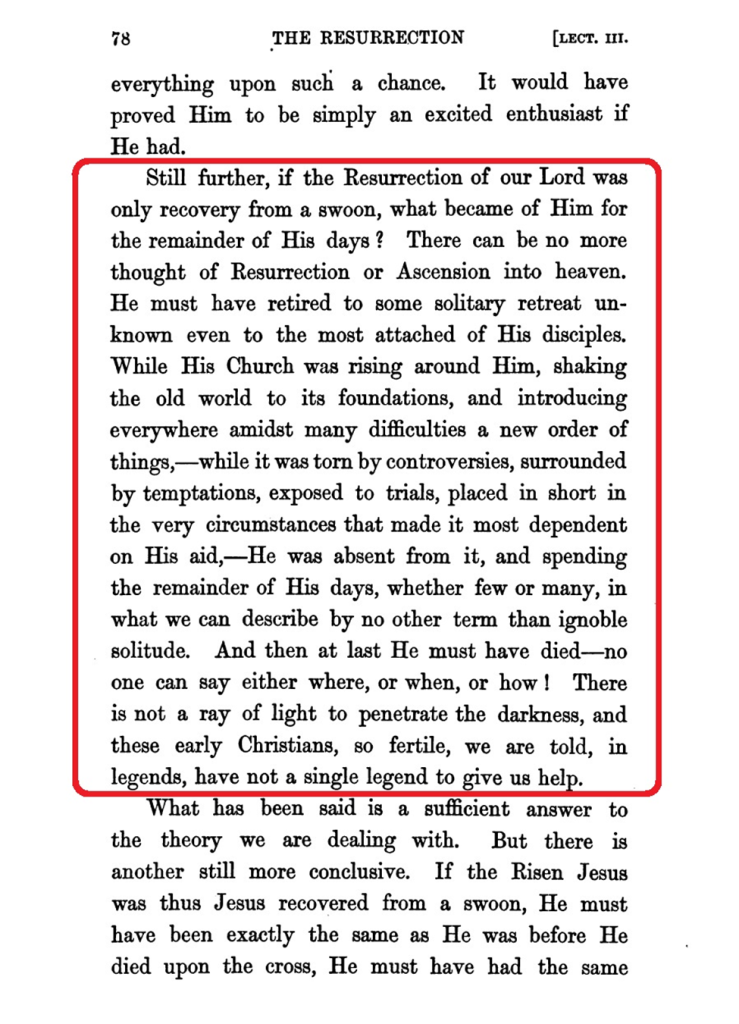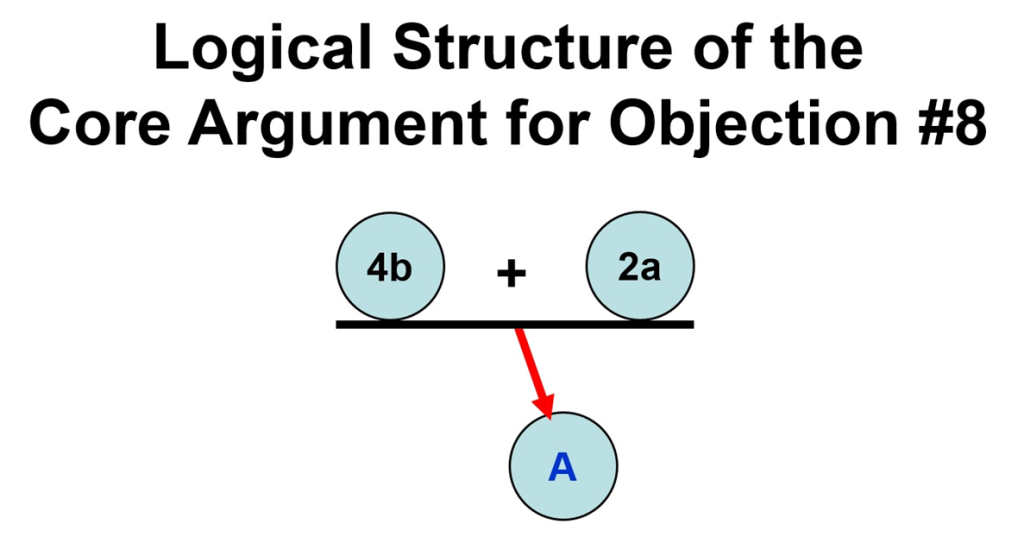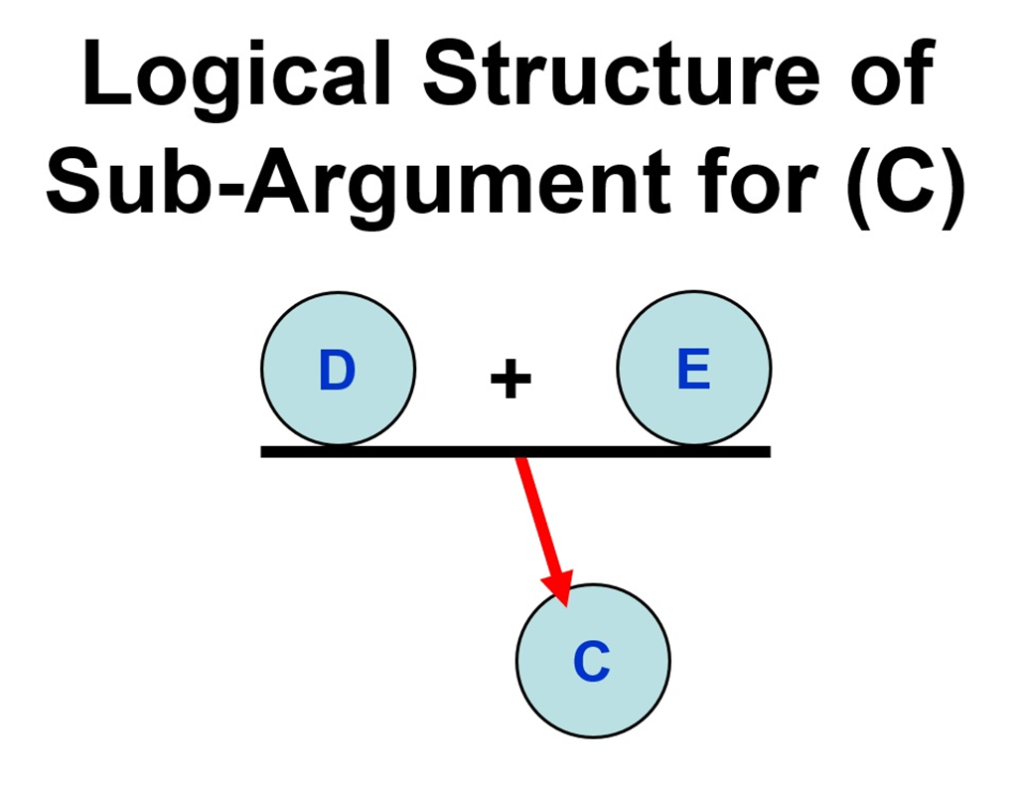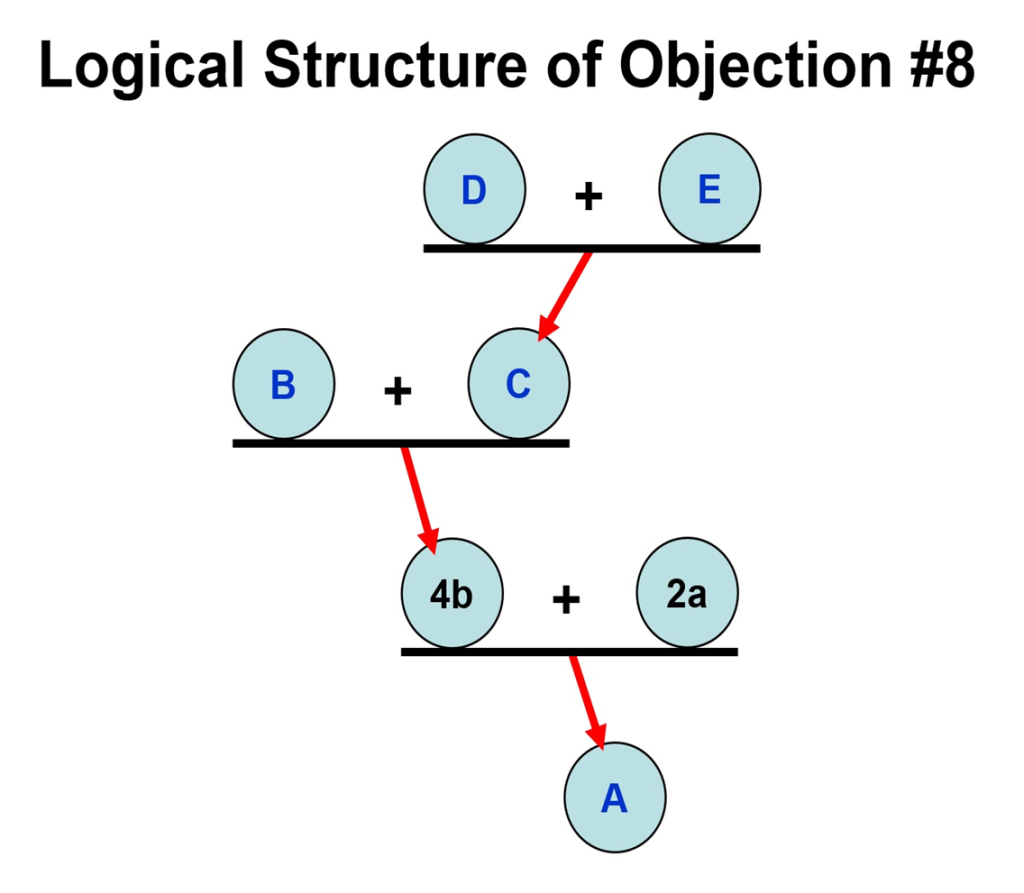Careful Analysis of Objections to the Swoon Theory: Objection #8 (Where Did Jesus Go?)
WHERE WE ARE
Careful argument evaluation is the heart and soul of critical thinking. But in order to do a careful evaluation of an argument, one must first have a clear understanding of the argument that is to be evaluated. Careful argument analysis is usually required in order to obtain a clear understanding of an argument, so having the knowledge, skills, and desire to do careful argument analysis is crucial to being a critical thinker.
I have carefully evaluated nine objections against the Swoon Theory, objections put forward by Peter Kreeft and Ronald Tacelli in Chapter 8 of their Handbook of Christian Apologetics. I arrived at the conclusion that all nine objections FAIL, and thus that their case against the Swoon Theory FAILS, and their case for the resurrection of Jesus FAILS. But in order to be in a position to do this, I had to first do a careful argument analysis of each objection (each objection constitutes an argument against the Swoon Theory).
In this post I will walk through my process of careful argument analysis, step-by-step, showing how the sausage gets made. The process of careful argument analysis that I use here can be applied to almost any text or speech that contains an argument or arguments. This post will focus on Objection #8 against the Swoon Theory.
ANALYSIS OF OBJECTION #8
Objection #8 is the second of two objections against the Swoon Theory that are NOT based on the Gospels:

OBJECTION #8: WHERE DID JESUS GO?
Kreeft and Tacelli’s Objection #8 against the Swoon Theory does not rest on Gospel passages:
If Jesus awoke from a swoon, where did he go? Think this through: you have a living body to deal with now, not a dead one. Why did it disappear? There is absolutely no data, not even any false, fantastic, imagined data, about Jesus’ life after his crucifixion, in any sources, friend or foe, at any time, early or late. A man like that, with a past like that, would have left traces.
(HCA, p. 184)
IDENTIFICATION STEPS
If Jesus awoke from a swoon, where did he go? – This is not a rhetorical question. This sentence does not appear to make any claim.
Think this through: you have a living body to deal with now, not a dead one. – This sentence makes a claim, but it does not seem to be a significant claim.
Why did it disappear? – This is also not a rhetorical question, although it does assume something:
1. [After Jesus was crucified and then allegedly came back to consciousness, he disappeared.]
2. [There is absolutely no data, not even any false, fantastic, imagined data, about Jesus’ life after his crucifixion, in any sources, friend or foe, at any time, early or late.]
3. [A man like that, with a past like that,]
4. [would have left traces.]
CLARIFICATION STEPS
1. [After Jesus was crucified and then allegedly came back to consciousness, he disappeared.] – I’m not going to clarify this claim, because it seems to be a less clear version of claim (2).
2. [There is absolutely no data, not even any false, fantastic, imagined data, about Jesus’ life after his crucifixion, in any sources, friend or foe, at any time, early or late.] – This claim seems sufficiently clear as it stands.
3. [A man like that, with a past like that,] – This is a very unclear claim. I have no idea what Kreeft and Tacelli mean by these two instances of the phrase “like that”. Perhaps a review of other Christian apologists who raise a similar objection against the Swoon Theory might provide a hint at what Kreeft and Tacelli had in mind here:
=>3a. Jesus was a man who was like Jesus (unclear), and Jesus hada past like Jesus’ past (unclear).
4. [would have left traces.] – Because this is an objection against the Swoon Theory, it makes sense to restate this claim in terms of the Swoon Theory. Also, most of the objections that Kreeft and Tacelli make against the Swoon Theory can be understood as reduction-to-absurdity arguments, so it makes sense to understand claim (4) as a conditional claim indicating an implication of the Swoon Theory:
=>4a. IF the Swoon Theory is true, THEN there would be historical data about Jesus’ life after his crucifixion.
FILL IN STEPS
The core of the argument for Objection #8 is clear:
4a. IF the Swoon Theory is true, THEN there would be historical data about Jesus’ life after his crucifixion.
2. There is absolutely no data, not even any false, fantastic, imagined data, about Jesus’ life after his crucifixion, in any sources, friend or foe, at any time, early or late.
THEREFORE:
A. The Swoon Theory is false.
Claim (3a) is supposed to be a reason in support of claim (4a), but (3a) is very unclear as it stands. Before we attempt to figure out what (3a) might mean, there is an obvious problem with premise (2) that needs to be addressed.
Premise (2) is clearly and obviously FALSE. We could just interpret premise (2) as meaning what it says, and immediately toss this argument aside as being UNSOUND. But it would be more reasonable and fairer to Kreeft and Tacelli, to see if there is a way to make some minor modifications to premise (2), so that it was not clearly and obviously FALSE, so that this key premise of their argument was true or at least somewhat plausible.
According to the Gospels and the book of Acts, and according to Paul’s first letter to the Corinthians, a living Jesus made various appearances to his disciples and followers after he had been crucified. Kreeft and Tacelli are well aware of this, and yet premise (2) directly contradicts these obvious facts about the New Testament writings. The most reasonable conclusion is that Kreeft and Tacelli neglected to make some qualifications to premise (2), so that this claim would not clearly contradict these obvious facts about the New Testament.
Here is how I would modify premise (2) so that it does not directly contradict the above facts about the New Testament and is at least somewhat plausible:
2a. There is absolutely no data, not even any false, fantastic, imagined data, about Jesus’ life after his crucifixion, other than some stories in the New Testament about alleged appearances of a living Jesus to some of his disciples that took place for a few weeks after Jesus was crucified and then the appearances ceased, in any sources, friend or foe, at any time, early or late.
But if we make this modification to premise (2), the logic of the core argument for Objection #8 will no longer be VALID:
4a. IF the Swoon Theory is true, THEN there would be historical data about Jesus’ life after his crucifixion.
2a. There is absolutely no data, not even any false, fantastic, imagined data, about Jesus’ life after his crucifixion, other than some stories in the New Testament about alleged appearances of a living Jesus to some of his disciples that took place for a few weeks after Jesus was crucified and then the appearances ceased, in any sources, friend or foe, at any time, early or late.
THEREFORE:
A. The Swoon Theory is false.
This argument is no longer a VALID modus tollens argument, because premise (2a) does not deny the consequent of the conditional claim made by (4a). Instead of denying the consequent, (2a) affirms the consequent of (4a), because it implies that the New Testament contains historical data about Jesus’ life after his crucifixion.
In order to preserve the logical validity of the original argument, we must now also modify premise (4a), so that premise (2a) denies the consequent of the conditional claim.
4b. IF the Swoon Theory is true, THEN there would be historical data about Jesus’ life after his crucifixion and after his alleged appearances to some of his disciples that took place for a few weeks after Jesus was crucified.
2a. There is absolutely no data, not even any false, fantastic, imagined data, about Jesus’ life after his crucifixion, other than some stories in the New Testament about alleged appearances of a living Jesus to some of his disciples that took place for a few weeks after Jesus was crucified and then the appearances ceased, in any sources, friend or foe, at any time, early or late.
THEREFORE:
A. The Swoon Theory is false.
As I stated previously, premise (3) is too UNCLEAR to provide any significant support for the key premise (4b), so the following sub-argument is a bad argument:
3a. Jesus was a man who was like Jesus (unclear), and Jesus had a past like Jesus’ past (unclear).
THEREFORE:
4b. IF the Swoon Theory is true, THEN there would be historical data about Jesus’ life after his crucifixion and after his alleged appearances to some of his disciples that took place for a few weeks after Jesus was crucified.
In order to try to clarify the reasoning in support of (4b), I took a look at Josh McDowell’s objections against the Swoon Theory, to see if McDowell put forward a similar objection, and if so, how he supported the key premise (4b) or a similar key premise. There was no similar objection in McDowell’s book The Resurrection Factor, but I did find a similar objection in his book Evidence that Demands a Verdict (hereafter: EDV). The very last objection that McDowell raises against the Swoon Theory is given in a quote from William Milligan (The Resurrection of Our Lord, 1881, p78):

According to Milligan, if the Swoon Theory is true, then Jesus “must have retired to some solitary retreat unknown even to the most attached of His disciples.” In order for there to be no historical record of Jesus’ activity after the few weeks of appearances of the “risen” Jesus to his disciples.
Furthermore, Milligan clearly finds this to be implausible or very improbable, because Jesus would have wanted to give “aid” to his disciples in their struggles to establish the Christian church. Thus, Milligan thinks that the Swoon Theory is improbable because it implies that Jesus would have remained in “ignoble solitude” when his disciples were in desperate need of his guidance.
Since Kreeft and Tacelli appear to have borrowed many of their objections against the Swoon Theory from Josh McDowell, it is reasonable to use McDowell’s final objection (the quote from Milligan) against the Swoon Theory in EDV, which was published in 1972, more than two decades before Kreeft and Tacelli published HCA, as a supplement to clarify their UNCLEAR argument in support of the key premise (4b):
B. IF the Swoon Theory is true, THEN either (a) after his crucifixion and after a few weeks of appearing to his disciples Jesus retired to some solitary retreat unknown even to the most attached of his disciples, or (b) there would be historical data about Jesus’ life after his crucifixion and after his alleged appearances to some of his disciples that took place for a few weeks after Jesus was crucified.
C. It is NOT the case that: after his crucifixion and after a few weeks of appearing to his disciples Jesus retired to some solitary retreat unknown even to the most attached of his disciples.
THEREFORE:
4b. IF the Swoon Theory is true, THEN there would be historical data about Jesus’ life after his crucifixion and after his alleged appearances to some of his disciples that took place for a few weeks after Jesus was crucified.
Premise (C) is based on an assumption about Jesus’ character and motivations:
D. IF after his crucifixion and after a few weeks of appearing to his disciples Jesus retired to some solitary retreat unknown even to the most attached of his disciples, THEN Jesus refused to provide guidance to his disciples when his disciples were in desperate need of his guidance.
E. Jesus would NOT ever refuse to provide guidance to his disciples when they were in desperate need of his guidance.
THEREFORE:
C. It is NOT the case that: after his crucifixion and after a few weeks of appearing to his disciples Jesus retired to some solitary retreat unknown even to the most attached of his disciples.
DIAGRAMMING THE ARGUMENT

4b. IF the Swoon Theory is true, THEN there would be historical data about Jesus’ life after his crucifixion and after his alleged appearances to some of his disciples that took place for a few weeks after Jesus was crucified.
2a. There is absolutely no data, not even any false, fantastic, imagined data, about Jesus’ life after his crucifixion, other than some stories in the New Testament about alleged appearances of a living Jesus to some of his disciples that took place for a few weeks after Jesus was crucified and then the appearances ceased, in any sources, friend or foe, at any time, early or late.
THEREFORE:
A. The Swoon Theory is false.

B. IF the Swoon Theory is true, THEN either (a) after his crucifixion and after a few weeks of appearing to his disciples Jesus retired to some solitary retreat unknown even to the most attached of his disciples, or (b) there would be historical data about Jesus’ life after his crucifixion and after his alleged appearances to some of his disciples that took place for a few weeks after Jesus was crucified.
C. It is NOT the case that: after his crucifixion and after a few weeks of appearing to his disciples Jesus retired to some solitary retreat unknown even to the most attached of his disciples.
THEREFORE:
4b. IF the Swoon Theory is true, THEN there would be historical data about Jesus’ life after his crucifixion and after his alleged appearances to some of his disciples that took place for a few weeks after Jesus was crucified.

D. IF after his crucifixion and after a few weeks of appearing to his disciples Jesus retired to some solitary retreat unknown even to the most attached of his disciples, THEN Jesus refused to provide guidance to his disciples when his disciples were in desperate need of his guidance.
E. Jesus would NOT ever refuse to provide guidance to his disciples when they were in desperate need of his guidance.
THEREFORE:
C. It is NOT the case that: after his crucifixion and after a few weeks of appearing to his disciples Jesus retired to some solitary retreat unknown even to the most attached of his disciples.

STATED CLAIMS IN OBJECTION #8
2a. There is absolutely no data, not even any false, fantastic, imagined data, about Jesus’ life after his crucifixion, other than some stories in the New Testament about alleged appearances of a living Jesus to some of his disciples that took place for a few weeks after Jesus was crucified and then the appearances ceased, in any sources, friend or foe, at any time, early or late.
4b. IF the Swoon Theory is true, THEN there would be historical data about Jesus’ life after his crucifixion and after his alleged appearances to some of his disciples that took place for a few weeks after Jesus was crucified.
UNSTATED CLAIMS OR ASSUMPTIONS IN OBJECTION #8
A. The Swoon Theory is false.
B. IF the Swoon Theory is true, THEN either (a) after his crucifixion and after a few weeks of appearing to his disciples Jesus retired to some solitary retreat unknown even to the most attached of his disciples, or (b) there would be historical data about Jesus’ life after his crucifixion and after his alleged appearances to some of his disciples that took place for a few weeks after Jesus was crucified.
C. It is NOT the case that: after his crucifixion and after a few weeks of appearing to his disciples Jesus retired to some solitary retreat unknown even to the most attached of his disciples.
D. IF after his crucifixion and after a few weeks of appearing to his disciples Jesus retired to some solitary retreat unknown even to the most attached of his disciples, THEN Jesus refused to provide guidance to his disciples when his disciples were in desperate need of his guidance.
E. Jesus would NOT ever refuse to provide guidance to his disciples when they were in desperate need of his guidance.
EVALUATION OF OBJECTION #8
